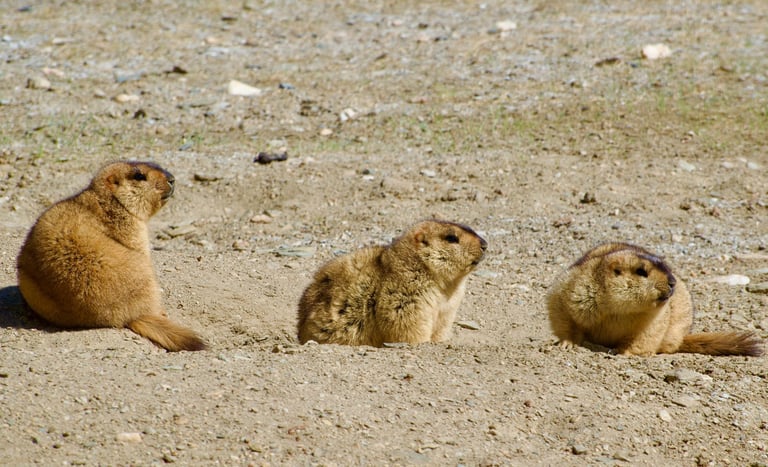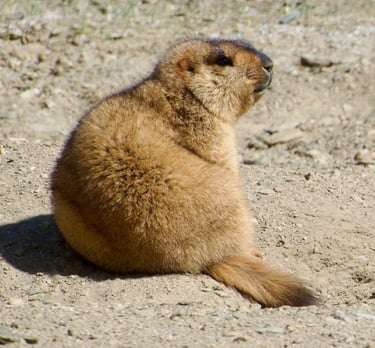Himalayan marmot, one of the largest ground squirrels, is a burrow dwelling herbivore found across Ladakh’s high altitude meadows. Known locally as 'Phia,' it hibernates for months and plays a importantl ecological role.
Himalayan Marmot: "Breaking Illusions to face the start reality"
By Rigzen Mingyur Gya


I have been born and brought up in a quaint village in East Ladakh called Rumtse Gya. Growing up in Ladakh makes you familiar with respecting nature, its flora and fauna. My family elders used to tell me stories about the Himalayan marmot ("Phia" in Ladakhi) handed down to them from their elders. A story, which I clearly remember was that "Marmots slap humans if they come near them, and the slap was hard enough to break the teeth. To add proof to the tall claim, my Grandfather said that he had experienced it when he had an encounter with an Himalayan Marmot. When I look back to that story, I think he was just trying to arouse our curiosity in understanding animal behavior and respecting their boundaries. The story did have the intended effect, not only was I scared but excited to catch a glimpse of this "slapping bird". The village elders also told us that these marmots would sleep in burrows for months, give birth and when they came out, they would have an entire family. To a young boy, everything seemed dramatic and thrilling, and to me the Himalayan marmots seemed to be a villain that I had to see to believe.
Truth be told, in spite of my desire to catch a glimpse of these birds, I only got to see them during my adolescence days when I was on a trek from Rumtse to Tsomoriri. The excitement on seeing them, and the disappointment that they don’t slap was paramount. I later learned more about their behaviour when I attended a tour guide training where one of the major highlights was Marmot. It was to aid the questions tourists might ask when travelling through the terrains of Ladakh. The training taught me about the ecological cycle, the important part marmots play in it and even the "kind" act of feeding marmot that humans often do, disturbs their habit and reduces their capability to feed themselves. I also learned that the chemical content in food destroys their bio-composition, for example marmots in tourist areas develop black fur on their back which is unnatural and their lifespan also reduces. I am often conflicted, with the notion that I used to work as a travel guide and rely on tourists for money, while these tourists owing to ignorance destroy the delicate ecology of Ladakh. I make it a point to not stop the tourists near marmots, because at the end it's not the money from the tourists that counts but the life of these "slapping birds".
The folklore and my own experience sparked an interest in me about protecting marmots. I read that they come under "squirrel" and specially "ground dwelling squirrel". Himalayan marmots are one of the largest marmots in the world, they hibernate in late autumn till early spring. They eat plants, especially juicy plants. Their predators are Snow leopard, Eurasian Lynx, Tibetan wolf, Red fox etc.
I have realized the important role that every species plays in nature, starting from the smallest to the biggest. Tourists In Ladakh, naturalists etc. would always talk about catching a glimpse of a Snow Leopard, Tibetan wolf, Pallas cat, Eurasian Lynx, Tibetan Argali etc. and in birds it is black neck crane, Snow cock, Bar headed goose etc. I am not denying their importance, but want to raise awareness about the role of the lesser known species. The lack of awareness will lead to an imbalance in nature in the near future.


Conclusion
Appreciating nature and wildlife is needed in today’s time, be it through respecting their boundaries or not interfering with their natural habitat. These small changes could be in the form of having stories about posters, slogans, notice boards in tourist areas.....One shouldn't wait for a marmot to slap sense into us, the change should begin before it gets too late. Some of the greatest and emergency of the state is that we can.
Himalayan Marmot: "Breaking Illusions to face the start reality"
Himalayan marmot, one of the largest ground squirrels, is a burrow dwelling herbivore found across Ladakh’s high altitude meadows. Known locally as 'Phia,' it hibernates for months and plays a importantl ecological role.
